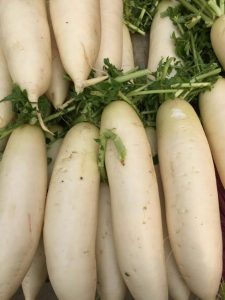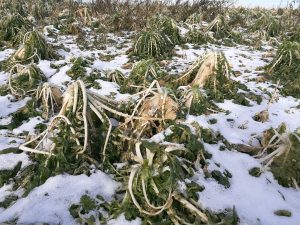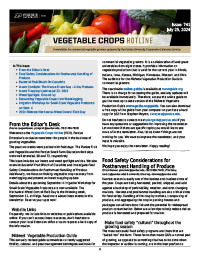Daikon radish is a member of Brassica family. It forms a large white tap root like a giant carrot. The tap root (12 to 20 inches long and 2 to 4 inches in diameter) penetrates into the soil leaving 2 to 6 inches protruding above ground. Radishes are cool-season crops. They are best grown with air temperatures in the range of 50 to 65°F. They grow fast, forming a dense canopy in the fall. They are winter killed when temperatures drop to low 20s °F for a few consecutive nights.
Daikon radish is a common and popular vegetable consumed in the southeast and Eastern Asia (Figure 1). The large and white roots have a favorable mild flavor, very low calorie content and rich in vitamin C. Fresh or picked diced daikon roots are important ingredients in a variety of dishes and soups in Asia cooking. Leaves are also consumed as green vegetables.
Although daikon radish is regarded as an ethnic vegetable, and not often present in food markets in the U.S., there is a growing interest in planting daikon radish as a fall cover crop because of its multiple agronomic benefits (Figure 2). Thanks to the strong and deep tap roots, daikon radish has been approved as an effective tool to reduce soil compaction. Studies have shown that it was four times more effective to help corn roots to penetrate compacted subsoil than winter fallow, and two times more effective than a rye cover crop. Daikon radish is also a great tool for weed suppression. A well-established daikon radish field can eliminate weed emergence in the fall and winter. The fast growth and heavy nitrogen feeding characteristics make Daikon radish a desirable N scavenger. After winter killed, daikon radish decomposes rapidly. Because they do not need to be killed or incorporated, there is no delay in spring field operations. However, as nitrogen from decomposed daikon radish is released in a short period of time, it is important to plant cash crop early to take advantage of the flush of nitrogen and to prevent nitrogen leaching.


